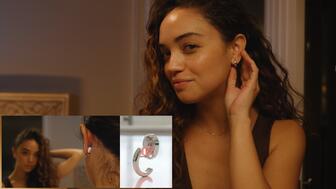Carlos Jose Hernandez and Joshua Zuazo were sentenced to life without the possibility of parole in the 2024 murder of Hussein “Sam” Murray.
Rocks On: Tanzanite comes into its own
In the second installment of Rocks On, National Jeweler takes a look at the current status of the tanzanite market and showcases 13 pieces of tanzanite jewelry.

But just 47 years ago, which is practically yesterday in the long history of gemstones, tanzanite was first spotted and brought to the market. Even though this gemstone is young in terms of being on the market, it’s grown in popularity quickly, now showing up in the creations of more designers and brands.
A Masai tribesman first found the gemstone in Tanzania in 1967. Once the industry realized that it was not, in fact, sapphire like many thought, Tiffany & Co. quickly made a deal to become its exclusive distributor.
The company gave it a name inspired by its country of origin and began marketing it with a major push in 1968. The stone increased in popularity almost immediately due to its high clarity, vivid color that can range from blue to violet to bluish-purple, and its potential for large cuts of stone.
Tanzanite became so popular, in fact, that in 2002 it became the first stone to be added to the birthstone list by the American Gem Trade Association since the list’s creation in 1912.
Now, in addition to its popularity in the U.S. market, Europe and Asia also are proving to be strong markets for the gemstone.
A limited supply
Tanzanite has only one source: it’s mined in the hills of Mount Kilimanjaro in northern Tanzania, on a strip of land that’s only about 4.5 miles long. Tanzanite One owns the largest and most advanced mine at the site.
“Geologists have said that at the current rate of mining, there will be no more tanzanite in the next 20 to 25 years,” said Hayley Henning of the Tanzanite Foundation, the nonprofit dedicated to promoting the gemstone.
Tanzanite, with its rich colors that can vary from pure blue to a bluish-purple or violet blue, has been picking up a lot of steam as of late. And the stone still has plenty of room to grow, especially given the fact that, due to a number of factors that include the politics of the region, the price of tanzanite has managed to stay relatively low.
“There
In recent years, tanzanite has benefitted greatly from the marketing and education efforts of the Tanzanite Foundation.
Established in 2003 by Tanzanite One, the organization has not only provided education about the stone but also has helped the lives of many people in Tanzania through its community outreach, including through the Masai Ladies’ Jewellery Project, a local orphanage, a primary school and a medical center.
The organization also created the internationally recognized system for grading tanzanite called the Tanzanite Quality Scale so that retailers would be able to help their customers choose the stone that’s best for them, based on the 4Cs criteria.
However, Henning announced in recent weeks that the Tanzanite Foundation, the first marketing agency of its kind in the colored gemstone world to provide support for one specific stone, would close its U.S. office effective at the end of August.
Henning wouldn’t give much information on the reasons behind the decision, other than to say that it was financial. She did note, however, that the move would not affect supply of the stone, only the marketing efforts.
A crowd favorite
In this digital age, where consumers can get the information they need at the click of a mouse, the fact that shoppers are learning more about tanzanite than ever before is combining with both their love for the stone’s color and support from designers and brands to create an opportune growth environment.
“Demand has truly never been higher than it is now,” Henning said. “Really it’s the color that they’re all going crazy for.”
More designers than ever before are turning to tanzanite to use in their pieces as the stone’s color and unique variations continue to attract more fans. Though it’s being seen across various price points, the stone is seeing a more of a boost coming from its placement at the higher end.
Even with the more limited supply and increased demand, the fact that the price has remained relatively low means that tanzanite can provide an accessibly priced alternative to more expensive gemstones of similar color.
Though it’s bound to gradually increase in price in line with rising awareness and demand, it has plenty of things going for it to help it along the way.
It also, for example, has the benefit of size, said designer Mark Schneider.
Larger loose stones are more prevalent for tanzanite than many other precious gemstones, with a few exceptions, and it’s these larger sizes that have the popular deep-blue hue. Schneider said it’s difficult to find other gemstones of comparable size, clarity and color at such a price.
A designer’s aesthetic
Pamela Froman, who has been using tanzanite in her designs for more than five years now, said that she first started using the gemstone because of its rich hue, attracted to the milky cabochon pieces and the way they looked with her textured yellow gold and gemstones such as rainbow moonstone, Paraiba tourmaline and opal.
However, the stone’s variation of hues, which is generally its selling point, also can be one of the things that makes it the hardest to use from a design standpoint, Froman said.
“It’s fabulous, but it can also be frustrating,” she told National Jeweler. “It can be frustrating when you’re trying to match it with other stones because the hues can change depending on the way you’re looking at it, the lighting, and the stones that surround it.”
While Froman prefers the milky cabochon tanzanite, she notes that the clear faceted pieces have been selling faster, a factor she thinks might be due to the fact that consumers don’t understand the value of the milky stone.
In addition to creating new designs with tanzanite, Froman also is capitalizing on the stone’s popularity by “repurposing” older designs with tanzanite.
While Froman tends to stick with smaller tanzanite stones, especially using them as accents, Schneider likes the opportunities that the larger tanzanite stones and their rich hues provide him when creating a piece, especially when compared to precious gemstones that offer the same shades of blue, particularly high quality sapphires.
“I prefer the tanzanite with the royal blue color,” he said. “Tanzanite gives you a big bang for less than a sapphire. It gives me something to work with that is big and bold. You get a color that is equal to a sapphire in my opinion, and sometimes even brighter than a sapphire in some cases, that can create these amazing pieces.”
He finds that many of his clients too prefer these rich, pure hues of blue exactly for this reason--their color saturation is comparable to that of a sapphire, and even though the price of tanzanite has gone up a little since he first started working in the stone, it hasn’t quite yet “ignited” in price, offering a great value for customers.
The Latest

Yood will serve alongside Eduard Stefanescu, the sustainability manager for C.Hafner, a precious metals refiner in Germany.

The New Orleans jeweler is also hosting pop-up jewelry boutiques in New York City and Dallas.

How Jewelers of America’s 20 Under 40 are leading to ensure a brighter future for the jewelry industry.

Set in a Tiffany & Co. necklace, it sold for $4.2 million, the highest price and price per carat paid for a Paraíba tourmaline at auction.


The jeweler’s “Deep Freeze” display showcases its iconic jewelry designs frozen in a vintage icebox.

Take luxury gifting to new heights this holiday season with the jeweler’s showstopping 12-carat sphene ring.

Roseco’s 704-page catalog showcases new lab-grown diamonds, findings, tools & more—available in print or interactive digital editions.

This year's theme is “Unveiling the Depths of the Ocean.”

In its annual report, Pinterest noted an increase in searches for brooches, heirloom jewelry, and ‘80s luxury.

Starting Jan. 1, customers can request the service for opal, peridot, and demantoid garnet.

The 111-year-old retailer celebrated the opening of its new location in Salem, New Hampshire, which is its third store in the state.

The new catalog features its most popular chains as well as new styles.

The filmmaker’s personal F.P. Journe “FFC” prototype was the star of Phillips’ recent record-setting watch auction in New York.

The new location in the Design District pays homage to Miami’s Art Deco heritage and its connection to the ocean.

Inflations, tariffs, and politics—including the government shutdown—were among consumers’ top concerns last month.

“Longtime favorite” presenters, as well as first-time speakers, will lead talks and workshops at the annual event in Tucson next year.

Silas Smith of Meridian Metalworks won the challenge with his pendant that blends Australian and American landscapes.

The sale of the 31.68-carat, sunset-hued stone was part of Sotheby’s first series of events and auctions in Abu Dhabi.

Most customers who walk into your store this month have made up their minds. Your job is to validate their choice, Emmanuel Raheb writes.

The collection features characters and motifs from Ukrainian folklore, including an enchanted mirror and a magic egg.

MatrixGold 3.11, the newest version of the jewelry design program, offers more flexibility, precision, and creative control.

The pavilion will be part of the 2026 JA New York Spring show, scheduled for March 15 to 17.

Kadet, a 1994 National Jeweler Retailer Hall of Fame inductee, helped grow the family-owned retailer in the Chicago area and beyond.

Billed as the world’s smallest wearable, Lumia Health’s new smart earrings have a health tracker subtly embedded in the back.

Don’t let those with December birthdays feel blue. Help them celebrate their month with blue zircon, turquoise, and tanzanite.

The new pink sapphire version of the piece dances with its wearer in the brand’s “Icons After Dark” holiday campaign.

























